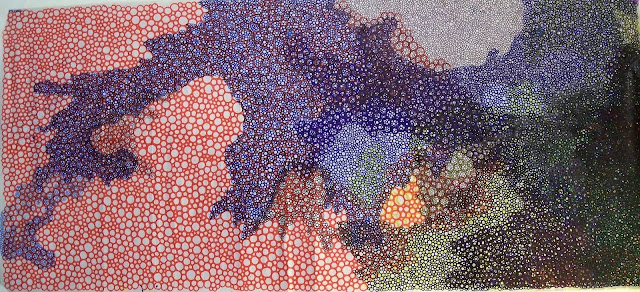When I was in my early twenties, I made drawings composed of layer upon layer of images from my imagination and my surroundings. The end result would be a highly colorful, complex, abstract image with a density of layering that obscured any and all forms. The layering of thousands of forms, chosen by me, would create a new, emergent, piece that I could not control, that at the time I thought was somehow beyond me or better than I could do consciously. These pieces were filled with fear, anger and hopelessness; I believe I came to make the drawings out of various feelings of self-hate, hopelessness and destruction associated with depression. In hindsight, I think I was trying to destroy myself, as author, from the work.
Years later, my drawings changed as I changed. The layered drawing technique became just a technique. I no longer had that negative energy to impart into the piece. The forms began to simplify. I also began to approach the act of drawing very differently: drawing was becoming an exercise of being-in-the-moment. Rather than dealing with negative emotions by what I drew, I dealt with them by the act of drawing. I eventually started drawing small circles that covered entire sheets of paper. Now, the combination of concentrated effort and the removal of form allows me to delve deeply into the act of drawing. There seems to be an infinite number choices about how to draw a simple circle or line. By distilling all the choices one makes while drawing, conscious and unconscious, I feel I am getting at something beyond drawing and myself. I am exploring this idea further by making tracings or drawing-over preexisting images.
The titles of these pieces were taken from a note book I keep of thoughts that I have while drawing. It is extremely difficult for me to sustain a deep concentration while drawing, especially drawing circles, and I will often find myself contemplating what I am doing. I also have a tendency to personify the drawings.
Years later, my drawings changed as I changed. The layered drawing technique became just a technique. I no longer had that negative energy to impart into the piece. The forms began to simplify. I also began to approach the act of drawing very differently: drawing was becoming an exercise of being-in-the-moment. Rather than dealing with negative emotions by what I drew, I dealt with them by the act of drawing. I eventually started drawing small circles that covered entire sheets of paper. Now, the combination of concentrated effort and the removal of form allows me to delve deeply into the act of drawing. There seems to be an infinite number choices about how to draw a simple circle or line. By distilling all the choices one makes while drawing, conscious and unconscious, I feel I am getting at something beyond drawing and myself. I am exploring this idea further by making tracings or drawing-over preexisting images.
The titles of these pieces were taken from a note book I keep of thoughts that I have while drawing. It is extremely difficult for me to sustain a deep concentration while drawing, especially drawing circles, and I will often find myself contemplating what I am doing. I also have a tendency to personify the drawings.
I draw circles so they wedge against each other, they want to fill in space. I create little tiny spaces as I draw, and fit in a circle just for that tiny spot. It is comforted, the surrounding one are hugging me. I am propped up to stand alone. (CIRCLES 001) 2009 - 9X10 - ball point pen on sketch paper.
As I wait for the pen to run out, I am very conscious of where I am drawing. I envision myself as pregnant, wanting it to “happen” in the right spot then if fades, I am not ready yet, plod on. (CIRCLES 007).
C007 Detail
C007 Detail
Circle drawing, circles on circles, layers in different pens. Hundreds of hours spent until the circles and the larger shape formed by the conglomeration of circles is lost in layering. In the same way my work is lost, my forms are lost, my hand is lost in the work. That is the direction these works are tending toward. The “artist” being removed from the work so as to overcome myself. (CIRCLES 008).
C008 Detail
One more second of this and I will die. (TRACING 002 drafted drawing cooling tower).
When examined with minute closeness all models collapse – then build more complex/bigger/more robust models, look closer, collapse. (TRACING 003 drafted drawing, strip mine topo).
Following the lines destroys the image. (TRACING 004 drafted drawing, strip mine topo).














